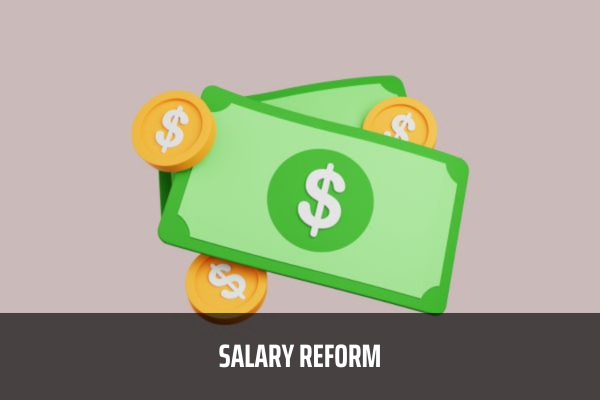What are the changes in incomes of Vietnamese officials when the payrolls issued under the salary reform policy come into force in 2024?
- What are the changes in incomes of Vietnamese officials when the payrolls issued under the salary reform policy come into force in 2024?
- What are principles for formulating 02 new payrolls for officials after the 2024 salary reform in Vietnam?
- Which types of allowances under the salary reform policy are applicable to officials and public employees in Vietnam?
What are the changes in incomes of Vietnamese officials when the payrolls issued under the salary reform policy come into force in 2024?
According to the spirit of the Resolution on the state budget estimate for 2024, which was voted and approved by the National Assembly on the morning of November 10, comprehensive reforms will be carried out in the salary policy following Resolution 27-NQ/TW in 2018.
Resolution 27-NQ/TW in 2018 calls for the annulment of the current statutory pay rate and salary coefficients, and the establishment of a new base pay based on specific amounts in the new payrolls.
The new payrolls system will be built based on positions, job titles, and leadership positions, replacing the current payrolls system. The transition from the old salary structure to the new one will ensure that salaries are not lower than the current level. The new payrolls include:
Payroll 1:
Payroll applicable to officials and public employees holding leadership positions (elected and appointed) in the political system from central to commune levels.
Payroll 2:
Payroll applicable to officials and public employees without leadership positions, based on their ranks and professional titles.
The income of officials and public employees based on the payrolls issued under the salary reform policy in 2024 will be structured as follows:
- Base pay: Accounting for about 70% of the total salary fund.
- Allowances: Accounting for about 30% of the total salary fund.
- Bonuses: Bonus funds will be equivalent to about 10% of the total salary fund for the year, excluding allowances.
According to the Government Electronic Portal, Minister of Home Affairs Pham Thi Thanh Tra stated that under the salary reform plan, starting from July 1, it is expected that the average salary of officials and public employees will increase by about 30% (including both the base pay and allowances).
From 2025 onwards, this salary level will continue to be adjusted annually, on average, by about 7%.
Although we have not implemented the salary reform in the past three years, the statutory pay rate has been adjusted twice, resulting in a 29.5% increase. Therefore, when calculating from 2021 (the expected implementation time of the salary reform according to the spirit of Resolution 27-NQ/TW in 2018) until July 1, the salary of officials and public employees has increased significantly, averaging about 60%. While this figure may not be extraordinary, it represents a considerable increase compared to the average annual increase of 7% without salary reform.
Therefore, when implementing the salary reform policy on July 1, 2024, the average income of officials from the payrolls issued under the salary reform policy in 2024 is expected to increase by about 30% (including both the base pay and allowances).
From 2025 onwards, the income of officials from salary will continue to be adjusted annually, on average, by about 7%.

What are the changes in incomes of Vietnamese officials when the payrolls issued under the salary reform policy come into force in 2024?
What are principles for formulating 02 new payrolls for officials after the 2024 salary reform in Vietnam?
Principles for formulating payroll 1:
Pursuant to Resolution 27-NQ/TW in 2018, it was agreed to formulate a position-based payroll applicable to officials holding leadership positions (elected and appointed) in the political system from the central to the commune level, based on the following principles:
+ The salary level must reflect the hierarchy within the political system; those holding leadership positions will receive salaries based on their respective positions. If a person holds multiple positions, they will receive the highest salary level. Those holding equivalent leadership positions will receive the same salary level. The salary level of higher-level leaders must be higher than that of lower-level leaders.
+ A fixed salary level is determined for each type of equivalent position; there is no classification of ministries, sectors, departments, committees, and equivalent units at the central level when constructing the position-based payroll at the central level. Different salary levels for the same leadership position based on the classification of administrative units at the local level will be implemented through allowances.
+ The classification of equivalent leadership positions within the political system for designing the position-based payroll will be decided by the Politburo after reporting to the Central Executive Committee.
Principles for formulating payroll 2:
Pursuant to Resolution 27-NQ/TW in 2018, it was agreed to formulte a professional and vocational-based payroll applicable to officials without leadership positions, based on their ranks. Each rank will have multiple salary levels based on the following principles:
+ For the same level of job complexity, the salary level will be the same. Higher labor conditions and occupational benefits will be implemented through vocational allowances. The classification of job groups and number of levels within officials' ranks and public employees' professional titles will be rearranged to encourage officials and public employees to improve their professional and vocational qualifications.
+ Appointment to officials' ranks or public employees' professional titles must be associated with the job position and the structure of officials' ranks and public employees' professional titles implemented by the managing agencies and organizations responsible for officials and public employees.
Which types of allowances under the salary reform policy are applicable to officials and public employees in Vietnam?
Pursuant to Resolution 27-NQ/TW in 2018, when implementing the salary reform in 2024, there are 9 types of allowances under the salary reform policy applicable to officials and public employees. They are as follows:
Multi-position allowance
Extra seniority allowance;
Region-based allowance
Responsibility allowance
Mobility allowance
Vocational-based preferential allowance
Allowance for working in areas with particularly difficult socio-economic conditions
Allowance based on the classification of administrative units
Allowance based on the ranking of public service providers
LawNet
